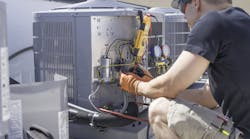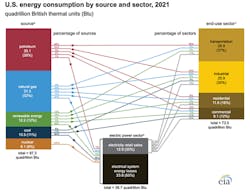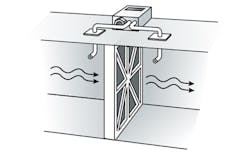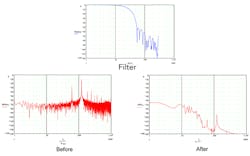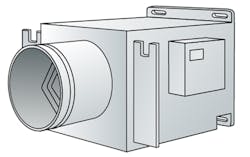What you'll learn:
- Statistics on energy consumption and subsequent CO2 generation.
- What is the impact of HVAC systems on energy consumption?
- Methods that can help reduce consumption and boost efficiency.
- What role do differential pressure sensors play?
Most energy generated in the United States is still derived from environmentally unfriendly fossil fuels. According to a U.S. Energy Information Administration (EIA) report from April 2022, 79% of all energy generated in the U.S. in 2021 was from non-renewal resources, specifically petroleum, natural gas, and coal. This represented a total of 76.9 quadrillion BTU of energy generated, resulting in 9.7 billion metric tons of carbon dioxide (CO2) released into the air (source of calculation: EPA greenhouse-gas equivalency calculator).
While growing, renewable energy, such as solar and wind, still comprise only 12% of the energy generated in the US.
Energy Consumption
The U.S. is one of the world’s largest generators of energy because of its high levels of consumption. The energy consumption can be categorized into four main sectors:
- Transportation
- Industrial
- Residential
- Commercial
Removing transportation, the other three categories made up 63% of all energy consumption in the U.S. in 2021. Further removing electrical grid energy losses (see table), these three sectors consumed 46.6 quadrillion BTU of energy that year, of which 37.9 quadrillion BTU was generated by a combination of petroleum, natural gas, and coal. This represents approximately 4.8 billion metric tons of CO2 released into the air (Fig. 1, source of calculation: EPA greenhouse gas equivalency calculator).
The Impact of HVAC Systems on the Environment
HVAC systems are a significant portion of residential and commercial energy consumption. While not the largest consumer of energy in the industrial sector, HVAC systems still use a fairly large amount of energy in this space. The table shows HVAC energy usage in 2021, based on data from the U.S. Department of Energy and the EIA.
Utilizing the same calculations as in the previous section, HVAC systems are responsible for the release of approximately 849 million metric tons of CO2 into the air.
Energy Efficiency Complements Migration to Clean Energy
To achieve CO2 reduction goals, methodologies must be implemented to increase efficiency of energy use. Looking specifically at HVAC systems, we can quantify how pressure sensors can lower energy consumption in two areas: air filters and VAV boxes.
Air filters
Dirty air filters make the HVAC system to work harder to push air, thus expending more energy. Most consumers and organizations wait too long to replace or clean their filters. According to the Department of Energy, replacing a dirty filter with a clean one can reduce energy consumption by as much as 15%. Differential pressure sensors can easily measure the air pressure on both sides of the filter and notify system users when the ideal time is to replace or clean that filter.
VAV boxes
Variable air volume (VAV) is a type of HVAC system that maintains a constant temperature while varying the airflow to heat or cool buildings. Each VAV terminal modulates according to the needs of the specific room or zone it’s serving. As a result, the HVAC system can provide various temperatures and fan speeds much more efficiently than traditional constant-air-volume systems. Differential pressure sensors measure the volume of air across two points and provide feedback to the control system to open or close dampers to maintain the appropriate temperature in each of its zones.
According to several industry studies, VAV boxes can reduce building HVAC energy usage by 30% or more.
In terms of CO2 reduction, both air-filter monitoring and installing VAV boxes can have a significant environmental impact, chipping away at the 849 million metric tons of CO2 released annually in the air in the U.S. Even a 20% reduction in energy consumption thanks to efficiency gains would eliminate almost 170 million metric tons of CO2 being generated. And that’s just in the U.S.—globally, the reduction in CO2 would be several times higher.
Differential Pressure Sensors for Air-Filter Monitoring
As mentioned, differential pressure sensors are a very effective way to measure the difference in air pressure before and after an air filter. One port of the sensor measures the airflow before the filter, commonly known as the upstream side. The other port of the sensor measures the airflow after the filter, known as the downstream side (Fig. 2).
The differential pressure sensor provides the air-pressure readings of both the upstream and downstream airflows. When the differential air pressure reaches a predetermined value, a notification is provided to alert those monitoring the HVAC system that the filter needs to be replaced or cleaned. This ensures the system continues to run optimally and reduces system energy consumption.
However, as with all electromechanical systems, differential pressure sensors are subject to external factors that can impact performance. For example, fans and blowers generate noise and vibrations that can affect the sensor’s accuracy.
Filtering out that noise before it reaches the sensing element will greatly improve accuracy. This can be accomplished by eliminating the external noise filtering components on the board design and integrating them directly into the differential pressure sensor. An integrated, advanced digital filter capability removes sensor induced mechanical noise before it becomes an error signal that can adversely impact overall system performance. In noise-prone conditions, a 100X to 1000X improvement is achievable.
Figure 3 illustrates an example of a 4th-order finite-impulse-response (FIR) filter customized to block pump noise above 50 Hz, which has noise of equal magnitude as the signal of interest. The lower graphs show the results achieved with advanced digital filtering.
Another consideration is the potential impact of power-line interference, as it can interfere with HVAC operation. Such noise, typically exhibited near power lines or power sources, is extremely frustrating when trying to make sensitive measurements at low voltages. Depending on your geographic location, the ac-induced noise is typically either 50 or 60 Hz.
The most common way to eliminate this ac noise is to add a 50- or 60-Hz notch filter to your product. A notch filter rejects the signals within a specified narrow band of frequencies and only allows signals outside of that band to be passed along. Integrating the notch filter in the pressure sensor can reduce system cost while more efficiently blocking the interference.
A final consideration when deploying sensors in a complex system is that various parts of the “air network” may have different pressure requirements. Having one differential pressure sensor that can support all of these different pressure requirements simplifies system design and guarantees consistent measurements across the HVAC system.
Differential Pressure Sensors for VAV Boxes
VAV systems maintain a consistent temperature and vary the airflow to achieve the desired conditions, and differential pressure sensors play a vital role in their operation (Fig. 4). Specifically, the sensors measure the volume of air across two points and provide feedback to the control system to open or close dampers to maintain the appropriate temperature in each of its zones.
While differential pressure sensors are a critical component of VAV systems, like air-filter monitoring, they’re subject to external factors that can impact performance, as well as potential power-line interference. For example, fans and blowers generate noise and vibrations that can impact the accuracy of the sensor. Filtering out that noise before it reaches the sensing element, and integrating a 50/60-Hz notch filter, will greatly improve accuracy.
A more important consideration when deploying sensors in a complex system is the need to maintain long-term stability because replacing sensors or VAV units is costly and time consuming, especially in larger HVAC implementations. Finally, since the various zones of the “air network” may have different requirements (e.g., an interior lab or server room vs. a window-facing conference room), the ability to have one differential pressure sensor that can support all of the different pressure requirements will maximize energy efficiency.
Summary
As the analysis above demonstrates, differential pressure sensors can play a significant role in reducing the release of CO2 in the air. In addition to air filters and VAV boxes, sensors could be deployed in positive pressure modules, and they’re a critical component of differential pressure transmitters.
When looking at differential pressure sensors, those most suited for HVAC applications will:
- Accurately detect even the smallest changes in air pressure.
- Support extremely low air pressures—even under 100 Pascal.
- Have excellent long-term stability so that accuracy doesn’t degrade over time.
- Can support multiple pressure ranges to maximize energy efficiency.
- Aren’t impacted by external interference from fans, blowers, and other machinery.
- Have integrated functionality such as advanced digital filtering, 50/60-Hz notch filter, and closed-loop control.
